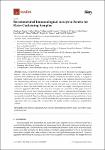Recommended Immunological Assays to Screen for Ricin-Containing Samples
Simon, Stéphanie
Worbs, Sylvia
Avondet, Marc-André
Tracz, Dobryan M.
Dano, Julie
Schmidt, Lisa
Volland, Hervé
Dorner, Brigitte
Corbett, Cindi R.
Ricin, a toxin from the plant Ricinus communis, is one of the most toxic biological agents known. Due to its availability, toxicity, ease of production and absence of curative treatments, ricin has been classified by the Centers for Disease Control and Prevention (CDC) as category B biological weapon and it is scheduled as a List 1 compound in the Chemical Weapons Convention. An international proficiency test (PT) was conducted to evaluate detection and quantification capabilities of 17 expert laboratories. In this exercise one goal was to analyse the laboratories’ capacity to detect and differentiate ricin and the less toxic, but highly homologuous protein R. communis agglutinin (RCA120). Six analytical strategies are presented in this paper based on immunological assays (four immunoenzymatic assays and two immunochromatographic tests). Using these immunological methods “dangerous” samples containing ricin and/or RCA120 were successfully identified. Based on different antibodies used the detection and quantification of ricin and RCA120 was successful. The ricin PT highlighted the performance of different immunological approaches that are exemplarily recommended for highly sensitive and precise quantification of ricin.
No license information

